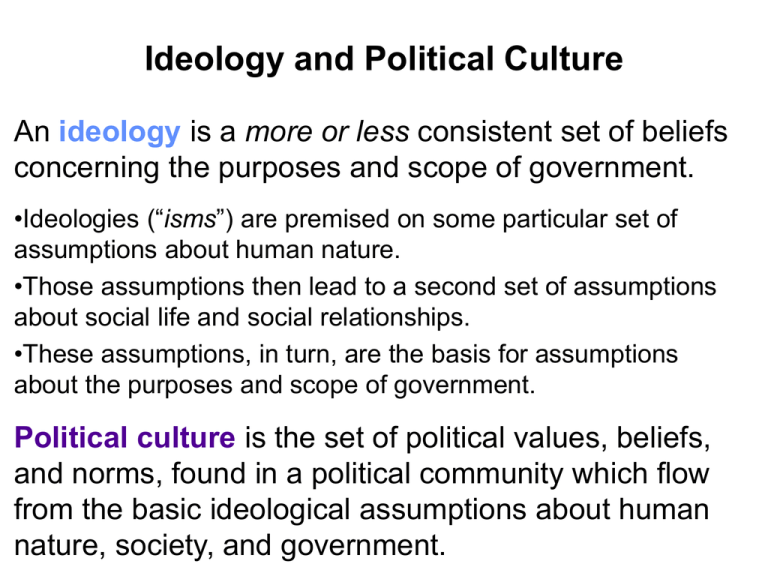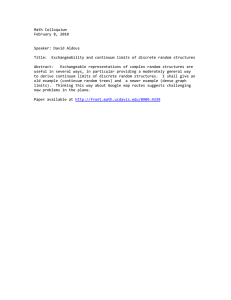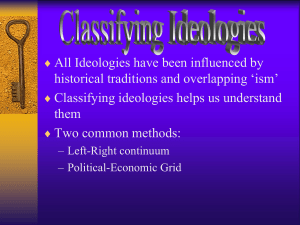Ideology and Political Culture An more or less
advertisement

Ideology and Political Culture An ideology is a more or less consistent set of beliefs concerning the purposes and scope of government. •Ideologies (“isms”) are premised on some particular set of assumptions about human nature. •Those assumptions then lead to a second set of assumptions about social life and social relationships. •These assumptions, in turn, are the basis for assumptions about the purposes and scope of government. Political culture is the set of political values, beliefs, and norms, found in a political community which flow from the basic ideological assumptions about human nature, society, and government. Two Levels of Ideological Thought FUNDAMENTAL ASSUMPTIONS SUPERFICIALS Assumptions concerning human nature, social life and social relationships, and the purposes and scope of government Particular values which flow from and are consistent with the fundamental assumptions and which focus on whether the “real world” converges or diverges with core assumptions; policy debate centers here Which of the following is the typically American assumption about human nature? •People are naturally good, intelligent reasonable, and mutually concerned about each other’s well being. These qualities of human nature are evident when people are not encumbered by arbitrary rules [that is, people do not have to be coerced into behaving in an orderly fashion]. •People are rational, self-interested, and acquisitive. Human beings are naturally competitive and are most productive in a society that value personal achievement to produce incentive. Human beings are imbued by nature with certain rights. •People are more emotional than rational. They are selfindulgent and incapable of making important decisions about how they will be governed. By their nature, people are driven by their desire to seek pleasure and avoid pain. Intelligence and talents are not evenly distributed. Which of the following is the typically American assumption about social life and social relationships? •Society is composed of a community of equals. In such a society, all persons share the “good life” because there is no privilege. •Ways must be found to harness the rational, selfinterestedness, and competitiveness of individuals so that the “general good” may be produced. This “general good” consists of a balance of private and public ends. •The irrational, hedonistic masses must be guided by the few with wisdom and talent so that the needs of society as a whole can be served. People are encouraged to be happy with their “station” in life. There is necessarily social stratification. Which of the following is the typically American assumption about the purposes of scope of government? •There is no need for coercive government; government, if it exists at all, is limited to a minimal role. People do not need government to provide order in their lives. By their nature, people respect the rights of their fellow members of society. •Government’s purpose is to provide a healthy environment to maximize individual opportunities and protect rights. Government must be prevented from interfering with the rights of individuals and their pursuit of individual happiness. •Government’s responsibility is to impose order on society. The masses are actually happiest in such an arrangement because their survival and well-being are guaranteed by a government vested with such authority. Ideologies pose two questions about government: • What is (are) the purpose(s) of government? • How much authority does government have to fulfill its purpose(s)? 3 Possible Purposes of Government • To maintain order (civil order, political order, economic order, social order) Original purpose • To serve rights and liberties of individuals • To promote equality Modern Once the ideology decides on the purpose(s) of government, it then asks “How much authority does government have to fulfill its purpose?” Based on the answer to this second question, we can place any ideology on a continuum indicating the scope of governmental authority - the so-called left-right continuum. Another problem with the continuum is that, in reality, leftist and rightist ideologies are not substantively that distinct. Thus, the ends of the continuum are closer to each other than they are to the middle. Autocratic Democratic Tendencies of the Left Tendencies of the Right Egalitarianism Class/race Bureaucratic Militarism Public property Private Property Socialism Capitalism Pluralism/Diversity Monism/Statism Although the left-right continuum has been used for many years by political scientists to describe competing ideological systems of thought, there are some problems with it. For one thing, the continuum does not make mathematical sense. As we move to the right on the number line the magnitude gets larger and as we move to the left the magnitude bets smaller. Therefore, we may re-orient [as indicated below] the continuum to reflect this mathematical fact. LIBERALISM AS THE MAINSTREAM OF AMERICAN POLITICAL THOUGHT The dominant system of political thought in American life has been one that:: (1) sees the individual as a rational, but self-interested person entitled by nature to certain inalienable rights such as life, liberty, and property; (2) suggests governments are created by contracts among such individuals to serve or protect these rights, but are otherwise limited in their authority; (3) argues that rights, contracts, and limits to governmental authority necessitate a major role for law [constitutionalism] in organizing society; (4) sees private striving as the best means for distributing economic and other rewards of social life [capitalism]. These four points are all fundamental assumptions of classical liberalism. They are assumptions that are widely held as fundamental truths in the American political mentality. From these assumptions flow particular values which are shared by most Americans even though they are not well-analyzed. Debate occurs over how to define, prioritize, and pursue (as a matter of public policy) these values. FREEDOM ECONOMIC FREEDOM PERSONAL CHOICE ISSUES ORDER EQUALITY ISSUES



